If you have left the door open in the Arundel area, you might be asked this question, rather than the more traditional expression, “Were you born in a barn?” Yapton is known as the village that never closes its doors, as tradition has it that the smugglers would come through the village on their way inland after landing their goods on Climping Beach and the villagers would leave their doors open as escape routes from ‘The King’s Men’.
Rumour locally has it that there is a tunnel in or near the parish church which was used by the smugglers. There is also a tale about how the Vicar gave a sermon on the evils of smuggling, without knowing that the contraband had been hidden beneath his feet in the pulpit and yet another that the old tombs were used to hide the smugglers’ booty.
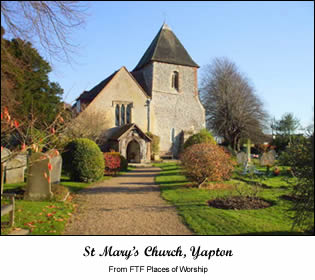
The horrific murder in 1748 of Richard Hawkins of Yapton by smugglers, who mistakenly thought that he had stolen some of their tea, was widely reported in the newspapers of the time.
Last Thursday sennight some Smugglers at Yapton in this County, missing a bag of Tea out of a barn where they had lodg’d it, suspected three Persons to have taken it, upon which they beat the two John Cockrels, Father and Son, in a barbarous Manner and afterwards went to the house of Richard Hawkins, with a Hatchet, threatening the Woman that they would cut her Child’s Head off, which was but half a year old, if she did not confess the Thing; but she absolutely denied knowing any Thing of the Matter; however, instead of hurting the Child, they went in Search of her Husband, found him, and carried him clear off, so that he has not been heard of since. London Evening Post – February 1748
On Sunday morning Last, Mr Justice Abney and Mr Justice Denison set out to hold the Assizes at East Grinstead, for the County of Sussex, which began Yesterday Morning, where a great many smugglers are to be try’d for Murders and Robberies, particularly five that were remov’d last Sunday from the County Goal of Surrey, under a strong guard of Dragoons, viz. John Mills, (Son of Richard Mills, lately executed at Chichester) for two Murders, one of Chater, the Shoemaker, and the other of Hawkins, at Yapton; Robert Fuller, and John Brown, otherwise Joeky Brown, also for the murder of Hawkins ,the poor Thresher of Yapton; and Lawrence and Thomas Kemp, two Brothers, ( the last of whom broke out of Newgate, some Time since) two notorious Smugglers, for Murder and Robbery and the same day Thomas Winter, one concern’d in the murder of Hawkins, was remov’d from Newgate, under a Guard, to give evidence against most of the above mention’d Smugglers. London Evening Post – March 1749
Whereas it has been represented to the King, That Richard Hawkins, late of Yapton in the County of Sussex, Labourer, being some time in the Month of January last, at work in a Barn near the same parish, was forcibly taken from thence by Jeremiah Curtis, alias Butler, late of Hawkhurst in the County of Kent, and John Mills, alias Smoaker, of Trotton in the County of Sussex, Labourer, and was by them carried into a Back Room in the Dog and Partridge Alehouse on Slindon Common; whereas Thomas Winter alias Coachman, alias Kentish Coachman, of Poling near Hythe in the County of Kent, Farmer; and a person called Rob, otherwise Little Fat Buck, Servant to Jared Curtis, which said Rob lives at or near East Grinstead, and is brother to a person living there, known by the name of the Cockler, were awaiting for them. In which Room they detained the said Richard Hawkins till about Twelve o’clock at Night; when the said Jeremiah Curtis, John Mills, Rob, and Thomas Winter went away, and took with them the said Richard Hawkins; who was not afterwards seen or heard of till his Body was found in a Pond in Parham Park, in the said County of Sussex; That the Coroner’s Inquest having sat on the said Body, found it to be the Body of the said Richard Hawkins, and brought in their verdict, Wilful Murder by Persons unknown. London Gazette 1749.
John Mills was part of a group, the Hawkhurst Gang, that committed two even more grisly murders less than a fortnight later.
Smuggling was endemic along the Sussex Coast, and smuggling activities are well documented in East Sussex, especially in the Hastings area, though less well so in West Sussex.
“Sussex men that dwell upon the shore
Look out when storms arise and billows roar;
Devoutly praying with uplifted hands
That some well-laden ship may strike the sands.
To whose rich cargo they may make pretence.”
EPILOGUE from “The Mourning Bride” 1697. William Congreve.
The coastline between Brighton and Portsmouth was ideal for smuggling. The gently shelving shores were ideal for landing the boats to offload the cargo. Inland there was easy access to the ancient droveways which ran across the Downs. About the only stretch of the coast which looks much the same as it did then is Climping Beach. When the tide is in, it is a two mile stretch of shingle, at low tide revealing an expanse of smooth sand. It reaches from Littlehampton and the River Arun to the east to Elmer and Middleton on Sea in the west, backed by sand dunes and farmland. Being isolated, it was an ideal place for the smugglers to land their contraband. Smugglers particularly favoured Elmer Sluice on the eastern edge of Middleton.

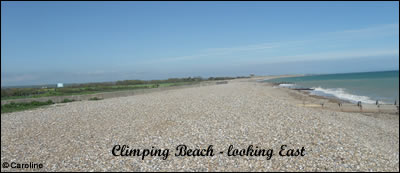
A SMUGGLER SHOT. On Tuesday night as a party of six smugglers were proceeding along the coast, near Middleton, about two miles from Bognor, they were stopped by Lieut. Newnham and his party, belonging to the Preventative Guard, when a serious conflict ensued. A most powerful fellow, named Charles Horn, attacked the Lieutenant, whom he knocked down. The latter, however, recovering himself, seized his antagonist, and, drawing a pistol from his pocket, threatened to fire if he made any more resistance. The smuggler instantly snatched a second pistol from the lieutenant’s pocket, but before he had time to cock it, the Lieutenant fired at the smuggler, who fell dead at his feet. The other five were taken; but one of them is covered with wounds and not expected to survive. Horn, who was shot, has left a widow and five children; and, we understand, was only discharged from prison about nine days ago, where he had been confined for a smuggling transaction. Lieut. Newnham lies in a dangerous state. The whole of the men have large families, one of them eight children. Hampshire Telegraph and Sussex Chronicle June 1825
From the beach, the smugglers would be able to quickly move their contraband inland. The River Arun was navigable and after 1823, a canal was constructed from London to Portsmouth that linked the rivers Arun and Wey to the River Thames in London. The canal, now disused and dry, passed through Yapton.
The area was not well served by Preventative men to begin with, although the situation improved later. In the 1740s, there was only one Customs House Officer in Littlehampton who was reputed to be “…. of no more use than a gull on the beach.” Four unmounted coastguards had been established at Felpham near Middleton, in about 1295, as one of only three such places in the rape of Arundel. Later, Riding Officers for Felpham were appointed from 1699, regiments of Dragoons were stationed at Chichester and Arundel and in the 1810s and 20s a coastguard officer, two preventative officers, and many boatmen, presumably stationed at Bognor, were recorded.
Newspaper reports show the value and quantity of goods which were seized, as well as giving an indication of the numbers of men involved:
Wednesday last, a Party of Lord Sheffield’s Dragoons from Chichester, seized 637 Tubs of Brandy and Gin, 900 Weight of Tea, three bags of Tobacco, and other articles and a few Days before, a Party from the same Regiment from Arundel made a considerable seizure, the share of the Dragoons, alone, amounting to upwards of 500l. A detachment of fifteen of them with a Supervisor lately fell in with upwards of 400 Smugglers, mounted, coming out of a Wood, the greatest Number ever seen together, but as they had not then any Goods nothing happened. St James’s Chronicle or the British Evening Post – June 1781
TO BE SOLD BY AUCTION at the CUSTOM-HOUSE, CHICHESTER
At ten o’clock in the morning.
The undermentioned GOODS, which have been seized and legally condemned, viz.
14 5lb Hylon Tea, in Chests
1102 lb. Green Tea
3043 lb. Bohea Tea
803 lb. Cobgou Tea
1200 Gallons Brandy
1100 Gallons Rum
2740 Gallons Geneva
Which goods may be viewed and tasted in his Majesty’s warehouse, in the said port (in proper hours) one day before the sale. Morning Chronicle and London Advertiser – August 1780
Goods were smuggled in vast quantities, involving great organisation of men, wagons and horses. Communication was difficult and systems of signalling were set up including the use of beacons and the sails on windmills. John Oliver who died in 1793 and who was said to have used the sails of his windmill to pass on signals to the smugglers is buried on Highdown Hill, north of Worthing. One of the many stories surrounding him, is that his tomb was built as a place for hiding his and others’ contraband.
The Hawkhurst Gang
There were several gangs operating in Sussex over the years, but the most notorious of them was the one based in the East Sussex village of Hawkhurst who operated right across Sussex, Kent, Hampshire and into Dorset. A characteristic of this gang was the way they took over the other groups and would browbeat them into co-operation. Their notoriety stemmed from their use of extreme violence and their boast that they could gather together up to 500 men at a couple of hours notice. Other gangs were probably as violent but the Hawkhurst gang were best known because of the case heard at the Special Assize in Chichester, held in January 1749.
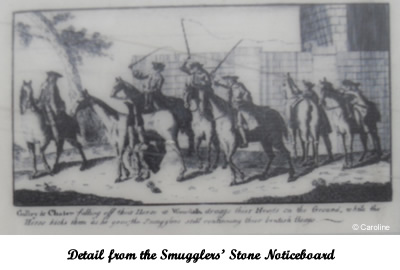
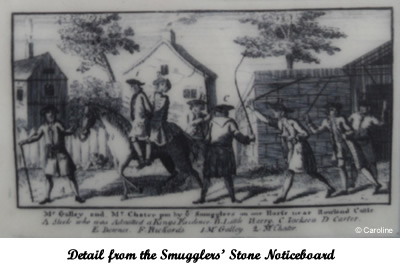
The gang had been waiting on the Sussex shore for a cutter to arrive from Guernsey. The cutter had been intercepted off the Dorset coast and, after a long chase, the crew had surrendered and were taken ashore at Poole. The gang attacked the Customs House to retrieve their goods and the Customs Service offered a £500 reward for their capture. One of the smugglers had been recognised by a cobbler, Daniel Chater, and was jailed at Chichester.
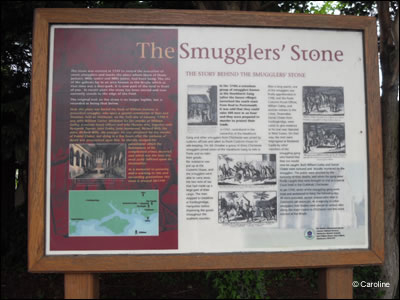
Subsequently, Chater was escorted to Chichester to give evidence and he and his escort, William Galley a Customs Officer, stopped for a drink at Rowland’s Castle en route to Chichester. The landlady betrayed them and the two men were kidnapped and viciously murdered. This took place two weeks after the murder of Richard Hawkins.The local population turned against the smuggler and gradually the leaders of the gang were arrested and brought to trial.
You can read a description of the trial by ‘A Gentleman of Chichester’, thought to have been made by the Duke of Richmond, on Smuggling & Smugglers in Sussex, an online book. They were convicted and executed and their bodies were exhibited in chains on gibbets around the county.
In Chichester, there is a stone which was erected in 1749 to mark the spot where the smugglers were hanged. The inscription is now completely obliterated, but the noticeboard placed next to it has a transcription. The inscription read:
“Near this place was buried the body of William Jackson, a prescribed smuggler, who upon a special commission of oyer and terminer held at Chichester on the 16th day of January 1748-9 was, with William Carter, attained for the murder of William Galley, a custom house officer and who likewise was together with Benjamin Tapner, John Cobby, John Hammond, Richard Mills the elder and Richard Mills the younger, his son, attained for the murder of Daniel Chater. But dying in a few hours after sentence of death was pronounced upon him he thereby escaped the punishment which the heinousness of his complicated crimes deserved and which was the next day most justly inflicted upon his accomplices. As a memorial to posterity and a warning to this and succeeding generations this stone is erected A.D. 1749.”
Although there are few signs left today of the smugglers’ haunts, the coastguard cottages have been converted to B and Bs and many of the inns no longer exist, it is still possible to stand on a deserted Climping Beach or walk along the high hedged Sussex footpaths and lanes and imagine the scenes.
Caroline
© Caroline 2009
SOURCES
Anecdotes from the neighbours!
Smuggling in Kent and Sussex 1700-1840 by Mary Waugh. Countryside Books 1985.
The Burney Collection: 17th and 18th Century Newspapers.